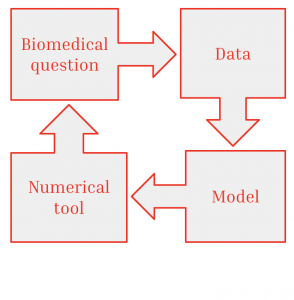The overall objective of SIMBIOTX is the implementation of computational models and tools in systems medicine, systems toxicology and systems biotechnology to guide clinical and experimental designs and decisions.
Our research program will target these topics based on a common workflow (Fig. 1) for which linking data and models plays a crucial role.
In medicine, clinical decisions are still largely guided by clinical experience, as completely standardized workflows and protocols are hampered the complexity of the human body and the variety of patient responses on therapeutic approaches.
Medicine permits acquisition of an increasing amount of data on the individual patient at all levels, which requires correct interpretation and processing to ensure the optimal decisions for each patient are taken. SIMBIOTX aims at better understanding by in-silico modeling how non-invasive imaging reflects the underlying organ architecture, perfusion and function.
In synergy with the first aim, SIMBIOTX aims at guiding clinical decisions by mathematical models integrating the data to inform clinicians and build predictions of possible therapy consequences.
Both, models and software generated in that process will pertain to standardization.
Systems toxicology aims at grasping the complexity of a substancesystem interaction, ideally by direct extrapolation from in vitro toxicological experiments to human toxicity, thereby reducing animal experiments. SIMBIOTX aims at building models explaining the outcome of in vitro experiments and guiding in vivo toxicity predictions from in vitro toxicity data, eventually by building spatial-temporal in silico abstractions of the in vitro and in vivo systems.
Moreover, models shall assist in predicting multiple drug effects.
Biotechnology increasingly develops sophisticated experimental set ups that more and more resemble in vivo systems to permit realistic experiments with human material in vitro that otherwise cannot be performed, and to generate replacement tissue to long-term replace donor organs in transplantations.
SIMBIOTX aims at calibrating models with this data, to explain properties of the bioengineered products and the processes leading to them, to assess their similarity to their prospective in-vivo system counterpart, and to guide their designs by mimicking bioengineering process scenarios.
As a proof of concept and backbone of the project, particular emphasis will be on liver and liver cells.




